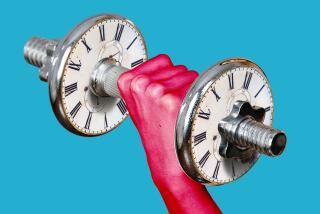‘No pain, no gain’ and other myths
- Share via
IT was once thought that vibrating belts could jiggle away fat and that physical exertion was unsafe for all pregnant women, seniors and people with heart disease.
These fitness myths and others have been debunked over the years, but various other misconceptions about exercise abound. Here, the fiction and the facts:
*
Myth: Sit-ups shrink love handles.
Truth: Abdominal exercises can tighten the muscles in your midsection but, because they burn so few calories, won’t shrink its overall size. For that, you need to lose fat all over the body.
“Spot reduction” is impossible, says Gerald Endress, fitness manager at the Duke University Diet and Fitness Center in Durham, N.C., which caters to overweight people trying to slim down. “You have no choice about where you’re going to take off the fat.”
To burn off the fat -- and show off those newly tightened abdominal muscles -- you’ll need to eat less and exercise more.
*
Myth: No pain, no gain.
Truth: You’ll have to work hard to go from flab to fab or to train for a triathlon, but exercise doesn’t have to be heart-pounding to help your heart or reduce the risk of diabetes, stroke and some cancers, says Dr. I-Min Lee, an associate professor of medicine at Harvard Medical School in Boston who studies the health effects of exercise.
“Even something moderate such as walking briskly can bring substantial benefit,” she says.
That’s why the surgeon general recommends that Americans strive for at least half an hour of moderate-intensity exercise such as brisk walking, swimming, biking or gardening on most days of the week.
And just as exercise doesn’t have to be painful to perform, it should never leave you in pain afterward either.
A little soreness a day or two after a new workout regimen is OK, but your body should never truly hurt, experts say. If it does, you’re overdoing it.
*
Myth: You can burn lots of calories even at rest.
Truth: “This is one of those things that tend to be a bit exaggerated,” says Cedric Bryant, chief exercise physiologist for the American Council on Exercise in San Diego.
It’s commonly thought that because muscle burns more calories than fat, strength training can dramatically speed up resting metabolism. But aside from serious bodybuilders and steroid users, most people don’t put on enough muscle to have a huge effect on their metabolism, according to Bryant.
The average woman who really works at it may gain two to three pounds of muscle, while a man may put on four or five, he says. Each pound burns roughly 15 calories a day, so it doesn’t add up to a lot of extra calories.
“We’re talking about a very modest increase,” Bryant says.
*
Myth: Heavy weights cause women to “bulk up.”
Truth: “Women just don’t have the physiology to bulk up,” says Shannon Morgan, a personal trainer in Newport Beach and a spokeswoman for the National Strength and Conditioning Assn.
Some women might look more muscular than others, but those who aren’t in heavy training and don’t use steroids need not worry.
Testosterone makes muscles bigger, and women don’t have nearly as much of the hormone as men do, she explains.
Nonetheless, Morgan estimates that 90% of her female clients worry about looking like a bodybuilder if they strength-train.
But working out with weights that are too light won’t yield the muscle tone many women desire.
Strength-training programs vary, but experts often recommend starting with one set of eight to 12 repetitions at a weight that fatigues the muscle by the last rep (meaning you can’t do even one more rep in good form).
*
Myth: Exercise requires lots of time and money.
Truth: Fitness doesn’t have to take a big bite out of your schedule or your wallet.
The surgeon general says that all exercise adds up, so people can get their half-hour a day of exercise in short 10- or 15-minute bouts -- two or three quick walks, for instance.
And walking is cheap. Expensive gym memberships and personal trainers are not required to get in shape.
There are plenty of other places to exercise, such as dance halls, swimming pools and hiking trails.
Personal trainers can be a help to beginners who need guidance getting started or to regular exercisers who want to shake up their workout routine from time to time, says Endress, but most people don’t need a trainer regularly.
*
Myth: Muscle turns to fat when you stop exercising.
Truth: “Muscle cells and fat cells are very different,” says Catherine Jackson, a professor and chairwoman of the department of kinesiology at Cal State Fresno and a spokesperson for the American College of Sports Medicine. “They do not convert from one type to another.”
But if you don’t keep fit, you will lose a fair amount of muscle mass with age, she says. And that will leave you looking flabby, particularly if you also pack on more fat.
*
Myth: If you exercise, you can eat anything.
Truth: Exercise doesn’t burn a tremendous number of calories, certainly not enough to make up for super-sized eating habits. A 160-pound man, for example, can burn 237 calories during 30 minutes of tennis and 372 calories during half an hour of jogging. Neither is enough to fully compensate for a Big Mac (560 calories) or a Starbucks grande mocha frappucino (420 calories).
“Sensible eating is critical,” says Bryant. “You just can’t look to exercise alone.”
*
Myth: Moderate activity is enough to get buff.
Truth: While half an hour of physical activity a day is enough for good overall health, it’s not enough to make most people lose weight or keep it off, according to Barbara Ainsworth, a professor of exercise and nutritional sciences at San Diego State University. “You’re just not burning enough calories,” she says.
In 2002, the Institute of Medicine recommended at least a full hour of moderate daily exercise for weight control. And of course, anyone hoping to get in shape for swimsuit season will also need strength training to firm up.
*
Myth: You can’t be fit and fat.
Truth: You can, just as you can be unfit and thin. Although it’s generally considered optimal to be fit and lean, studies have suggested that fit and fat people live longer than their thin, couch-potato counterparts.
Endress says he has clients who, after exercising for six months to a year, are still 50 to 100 pounds overweight. But their cardiovascular fitness is substantially improved. They can participate in aerobics classes and even jog a 5K.
*
Myth: You lose more weight if you exercise in the “fat-burning zone.”
Truth: Moderate-intensity exercise does burn a greater percentage of fat and a smaller percentage of carbohydrates than high-intensity exercise. That’s because as we engage in increasingly intense aerobic activity, our muscles pull more from our carbohydrate stores, burning more and more carbs, until we “hit the wall,” burning mostly carbs, and can’t go any further. But some people have concluded that it’s best to work out at lower intensities, in the so-called fat-burning zone.
Not so, says Kyle McInnis, a professor and chair of the department of exercise science and physical education at the University of Massachusetts in Boston. “The bottom line is, at the end of the day, how many calories did you expend compared to how many calories you took in?”
That answer is the one that matters. Not zones.
“There’s nothing magical about the fat-burning zone,” says Bryant. But it’s one of the most persistent fitness myths. “It’s like a cockroach,” he says. “You can’t kill it.”






